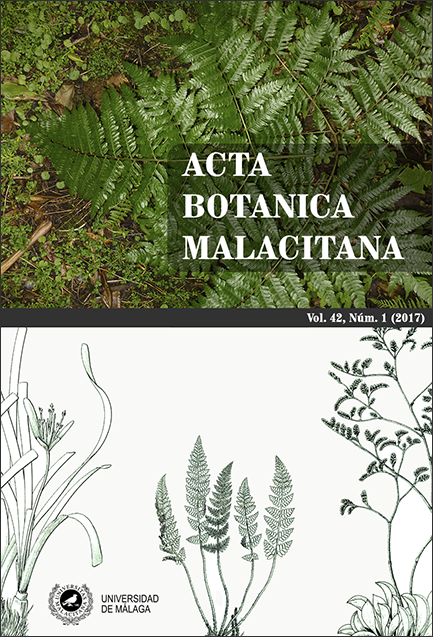A nex species of Elaphoglossum Schott ex J. Sm. (Dryopteridaceae) from Costa Rica.
DOI:
https://doi.org/10.24310/abm.v42i1.2973Abstract
Una especie nueva de Elaphoglossum Schott ex J. Sm de la sección Undulata Christ es descrita aquí: Elaphoglossum pallidosquamum A. Rojas & P. Muñoz. La nueva especie es similar a E. herpestes por su rizoma largo ascendente, pero difiere por escamas del rizoma no cordadas basalmente (vs. cordadas) y más pálidas pardo-amarillentas con margen blanquecino o completamente blanquecinas (vs. castañas), escamas del estípite adpresas (vs. adpresas a moderadamente patentes) y más densas, lámina más angosta 2.5-4 cm de ancho (vs. 5-6.5 cm) con base anchamente cuneada a obtusa (vs. redonda), lámina con diferentes tipos de escamas las costales imbricadas (vs. distantes entre sí), escamas adaxiales densas (vs. dispersas), escamas abaxiales enrrolladas y moderadamente densas (vs. escamas abaxiales planas y dispersas) y, escamas marginales muy densas (vs. moderadamente densas a dispersas) y estas más pálidas blanquecinas a amarillo pálido (vs. pardas).Downloads
Metrics
References
Gómez, L. D., & Arbeláez, A. L. (2009). Flora de Nicaragua. Tomo IV: helechos. St. Louis, Missouri: Missouri Botanical Garden.
Mickel, J. T. (1985). The proliferous species of Elaphoglossum (Elaphoglossaceae) and their relatives. Brittonia, 37, 261–278.
Mickel, J. T. (1987). New species of Elaphoglossum Elaphoglossaceae) from northern South America. Brittonia, 39, 313–339.
Mickel, J. T. (1991). Elaphoglossum. In RM Tryon & RG Stolze (Eds.), Pteridophyta of Peru. Part IV. 17. Dryopteridaceae (pp. 111–166). Fieldiana Botany, new series, 32.
Mickel, J.T. (1992). New species of the fern genus
Elaphoglossum from Mesoamerica. Novon, 2, 368–
Mickel, J.T. (1993). Six new species of Elaphoglossum
(Elaphoglossaceae). Brittonia, 45, 213-218.
Mickel, J.T (1995). Elaphoglossum. In RC Moran, R Riba (Eds.), Flora Mesoamericana: Volumen 1. Psilotaceae a Salviniaceae. México D. F.: Universidad Nacional Autónoma de México.
Mickel, J.T., & Atehortúa, L. (1980). Subdivision of the genus Elaphoglossum. American Fern Journal, 70, 47–68.
Mickel, J.T., & Smith, A. R. (2004). The Pteridophytes of Mexico. Memoirs of the New York Botanical Garden, 88, 1–1029.
Murillo, M.T., Murillo, J., León, A. & Triana, L.A. (2008). Los Pteridófitos de Colombia. Bogotá, D.C. Arfo.
Rojas, A.F. (1996). Twelve new species of Elaphoglossum from Costa Rica and Panama. Brenesia, 45–46, 7–26. Rojas, A.F., & Rodriguez, W.D. (2012). Dos especies nuevas de Elaphoglossum Schott ex J. Sm. (Dryopteridaceae) prolíferos para Colombia.
Actualidades Biológicas, 34, 183–186.
Rouhan, G., Dubuisson, J.Y., Rakotondrainibe, F., Motley,
T.J. , Mickel, J.T., Labat, J.N. & Moran, R.C. (2004). Molecular phylogeny of the fern genus Elaphoglossum (Elaphoglossaceae) based on chloroplast non-coding DNA sequences: contributions of species from the Indian Ocean area. Molecular Phylogenetics and Evolution, 33, 745–763.
Vasco, A. (2006). Elaphoglossum gemmatum (Elaphoglossaceae), a new species from Colombia. Brittonia, 58, 1–3.
Downloads
Published
How to Cite
Issue
Section
License
All information related to the licensing of published works in Acta Botanica Malacitana and copyright can be found in our Editorial Policy.







1.png)
